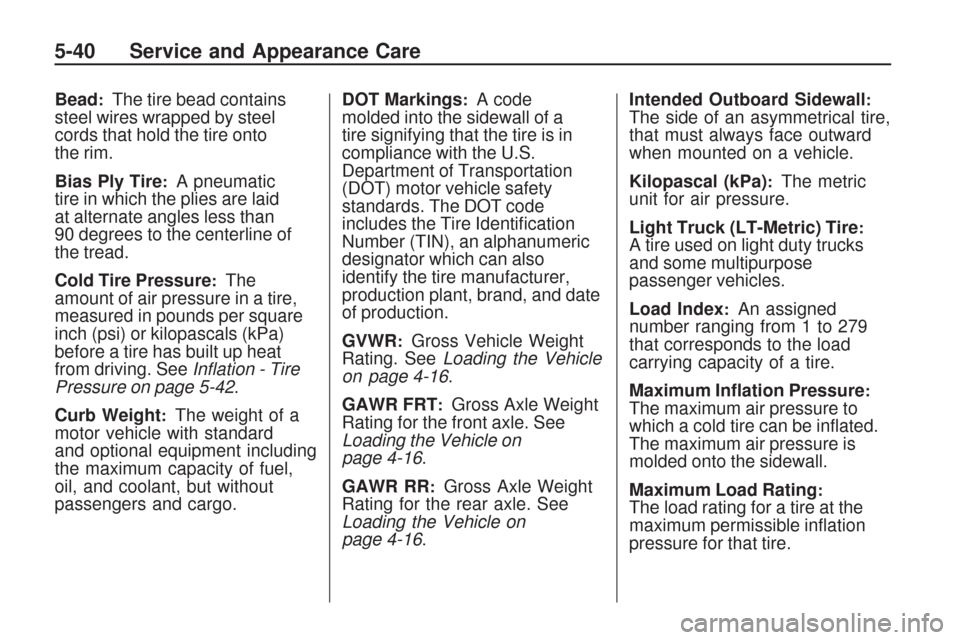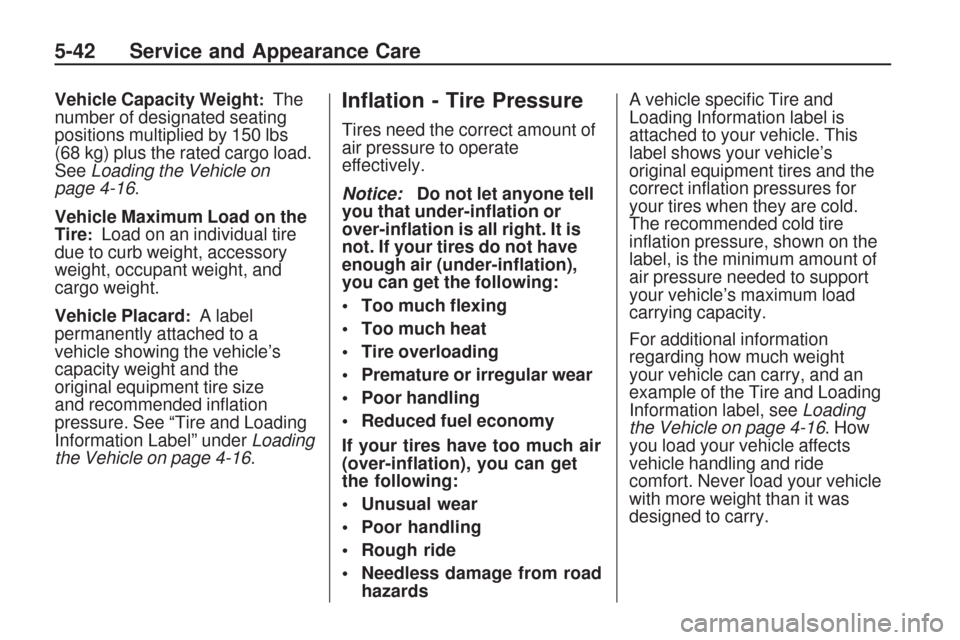2009 CHEVROLET TRAVERSE fuel cap
[x] Cancel search: fuel capPage 291 of 422

Checking Things
Under the Hood
{CAUTION
An electric fan under the hood
can start up and injure you even
when the engine is not running.
Keep hands, clothing, and tools
away from any underhood
electric fan.
{CAUTION
Things that burn can get on hot
engine parts and start a �re.
These include liquids like fuel, oil,
coolant, brake �uid, windshield
washer and other �uids, and
plastic or rubber. You or others
could be burned. Be careful not to
drop or spill things that will burn
onto a hot engine.
Hood Release
To open the hood, do the following:
1. Pull the hood release handle with
this symbol on it. It is located
under the instrument panel
on the driver’s side of the vehicle.
2. At the front of the vehicle, pull up
on the center of the hood, and
push the secondary hood release
to the right.3. After you have partially lifted the
hood, gas struts will automatically
take over to lift and hold the
hood in the fully open position.
Before closing the hood, be sure all
�ller caps are on properly.
Pull the hood down to close. Lower
the hood until the lifting pressure
of the strut is reduced. Then allow
the hood to fall and latch into place
under its own weight. Check to make
sure the hood is closed. If the hood
does not fully latch, gently push the
hood down at the front and center of
the hood until it is completely
latched.
Service and Appearance Care 5-9
Page 293 of 422

A. Radiator Pressure Cap. See
Cooling System on page 5-17.
B. Engine Coolant Recovery Cap.
SeeCooling System on
page 5-17.
C. Remote Negative (−) Terminal.
SeeJump Starting on page 5-29.
D.Underhood Fuse Block on
page 5-88.
E. Remote Positive (+) Terminal.
SeeJump Starting on page 5-29.
F.Power Steering Fluid on
page 5-24.
G. Engine Oil Fill Cap. See “When
to Add Engine Oil” underEngine
Oil on page 5-11.H. Engine Oil Dipstick. See
“Checking Engine Oil” under
Engine Oil on page 5-11.
I. Automatic Transmission
Fluid Dipstick. See “Checking
the Fluid Level” underAutomatic
Transmission Fluid on page 5-16.
J. Brake Master Cylinder Reservoir.
See “Brake Fluid” underBrakes
on page 5-25.
K.Engine Air Cleaner/Filter on
page 5-15.
L. Windshield Washer Fluid
Reservoir. See “Adding Washer
Fluid” underWindshield
Washer Fluid on page 5-24.Engine Oil
Checking Engine Oil
It is a good idea to check the engine
oil level at each fuel �ll. In order to
get an accurate reading, the oil must
be warm and the vehicle must be on
level ground.
The engine oil dipstick handle
is a yellow loop. SeeEngine
Compartment Overview on
page 5-10for the location of the
engine oil dipstick.
1. Turn off the engine and give the
oil several minutes to drain back
into the oil pan. If this is not
done, the oil dipstick might not
show the actual level.
2. Pull out the dipstick and clean it
with a paper towel or cloth, then
push it back in all the way.
Remove it again, keeping the tip
down, and check the level.
Service and Appearance Care 5-11
Page 322 of 422

Bead:The tire bead contains
steel wires wrapped by steel
cords that hold the tire onto
the rim.
Bias Ply Tire
:A pneumatic
tire in which the plies are laid
at alternate angles less than
90 degrees to the centerline of
the tread.
Cold Tire Pressure
:The
amount of air pressure in a tire,
measured in pounds per square
inch (psi) or kilopascals (kPa)
before a tire has built up heat
from driving. SeeInflation - Tire
Pressure on page 5-42.
Curb Weight
:The weight of a
motor vehicle with standard
and optional equipment including
the maximum capacity of fuel,
oil, and coolant, but without
passengers and cargo.DOT Markings
:A code
molded into the sidewall of a
tire signifying that the tire is in
compliance with the U.S.
Department of Transportation
(DOT) motor vehicle safety
standards. The DOT code
includes the Tire Identi�cation
Number (TIN), an alphanumeric
designator which can also
identify the tire manufacturer,
production plant, brand, and date
of production.
GVWR
:Gross Vehicle Weight
Rating. SeeLoading the Vehicle
on page 4-16.
GAWR FRT
:Gross Axle Weight
Rating for the front axle. See
Loading the Vehicle on
page 4-16.
GAWR RR
:Gross Axle Weight
Rating for the rear axle. See
Loading the Vehicle on
page 4-16.Intended Outboard Sidewall
:The side of an asymmetrical tire,
that must always face outward
when mounted on a vehicle.
Kilopascal (kPa)
:The metric
unit for air pressure.
Light Truck (LT-Metric) Tire
:A tire used on light duty trucks
and some multipurpose
passenger vehicles.
Load Index
:An assigned
number ranging from 1 to 279
that corresponds to the load
carrying capacity of a tire.
Maximum In�ation Pressure
:The maximum air pressure to
which a cold tire can be in�ated.
The maximum air pressure is
molded onto the sidewall.
Maximum Load Rating
:The load rating for a tire at the
maximum permissible in�ation
pressure for that tire.
5-40 Service and Appearance Care
Page 324 of 422

Vehicle Capacity Weight:The
number of designated seating
positions multiplied by 150 lbs
(68 kg) plus the rated cargo load.
SeeLoading the Vehicle on
page 4-16.
Vehicle Maximum Load on the
Tire
:Load on an individual tire
due to curb weight, accessory
weight, occupant weight, and
cargo weight.
Vehicle Placard
:A label
permanently attached to a
vehicle showing the vehicle’s
capacity weight and the
original equipment tire size
and recommended in�ation
pressure. See “Tire and Loading
Information Label” underLoading
the Vehicle on page 4-16.
In�ation - Tire Pressure
Tires need the correct amount of
air pressure to operate
effectively.
Notice:Do not let anyone tell
you that under-in�ation or
over-in�ation is all right. It is
not. If your tires do not have
enough air (under-in�ation),
you can get the following:
Too much �exing
Too much heat
Tire overloading
Premature or irregular wear
Poor handling
Reduced fuel economy
If your tires have too much air
(over-in�ation), you can get
the following:
Unusual wear
Poor handling
Rough ride
Needless damage from road
hazardsA vehicle speci�c Tire and
Loading Information label is
attached to your vehicle. This
label shows your vehicle’s
original equipment tires and the
correct in�ation pressures for
your tires when they are cold.
The recommended cold tire
in�ation pressure, shown on the
label, is the minimum amount of
air pressure needed to support
your vehicle’s maximum load
carrying capacity.
For additional information
regarding how much weight
your vehicle can carry, and an
example of the Tire and Loading
Information label, seeLoading
the Vehicle on page 4-16. How
you load your vehicle affects
vehicle handling and ride
comfort. Never load your vehicle
with more weight than it was
designed to carry.
5-42 Service and Appearance Care
Page 374 of 422

Capacities and Speci�cations
The following approximate capacities are given in English and metric conversions. SeeRecommended Fluids and
Lubricants on page 6-12 for more information.
Application Capacities
English Metric
Air Conditioning Refrigerant R134a For the air conditioning system refrigerant charge
amount, see the refrigerant caution label located
under the hood. See your dealer/retailer for more information.
Cooling System 11.4 qt 10.8 L
Engine Oil with Filter 5.5 qt 5.2 L
Fuel Tank 22.0 gal 83.3 L
Transmission Fluid* 5.3 qt 5.0 L
Wheel Nut Torque 140 lb ft 190 Y
*See Automatic Transmission Fluid on page 5-16 for information on checking �uid level.
All capacities are approximate. When adding, be sure to �ll to the approximate level, as recommended in this
manual. Recheck �uid level after �lling.
Engine Speci�cations
Engine VIN CodeTransmission Spark Plug Gap
3.6L V6 Engine DAutomatic 0.043 in (1.10 mm)
5-92 Service and Appearance Care
Page 412 of 422

B
Battery...............................5-28
Electric Power
Management.................3-15
Run-Down Protection.........3-16
Belt Routing, Engine.............6-15
Blind Spot Mirrors................2-34
Bluetooth
®.........................3-103
Brake
Emergencies...................... 4-5
Brake Fluid.........................5-25
Brakes...............................5-25
Antilock............................. 4-4
Parking...........................2-27
System Warning Light.......3-36
Braking................................ 4-3
Braking in Emergencies.......... 4-5
Break-In, New Vehicle..........2-20
Bulb Replacement................5-34
Fog Lamp ........................3-13
Halogen Bulbs..................5-33
Headlamp Aiming..............5-33
Headlamps......................5-33
Taillamps, Turn Signal,
Stoplamps and
Sidemarker Lamps.........5-33
Buying New Tires.................5-50
C
Calibration..........................3-54
California
Perchlorate Materials
Requirements................. 5-4
California Fuel....................... 5-5
California Proposition
65 Warning........................ 5-4
Camera, Rear Vision............2-38
Canadian Owners..................... ii
Capacities and
Speci�cations...................5-92
Carbon Monoxide.................2-11
Engine Exhaust................2-30
Liftgate............................2-10
Winter Driving..................4-14
Care of
Safety Belts.....................5-80
Cargo
Tie Downs .......................2-55
Cargo Cover.......................2-55
Cargo Management System . . . 2-55
CD, MP3 ....................3-92, 3-96
Center Console Storage........2-52
Chains, Tire........................5-55
Charging System Light..........3-34Check
Engine Lamp...................3-39
Checking Things Under
the Hood ........................... 5-9
Chemical Paint Spotting........5-84
Child Restraints
Infants and Young
Children.......................1-29
Lower Anchors and Tethers
for Children..................1-35
Older Children..................1-27
Securing a Child Restraint
in a Rear Seat Position....1-41
Securing a Child Restraint
in the Right Front Seat
Position.......................1-43
Systems..........................1-32
Where to Put the
Restraint......................1-33
Circuit Breakers...................5-86
Cleaning
Aluminum or Chrome-Plated
Wheels........................5-83
Exterior Lamps/Lenses......5-81
Fabric/Carpet...................5-79
Finish Care......................5-81
i-2 INDEX